In my spare time I read field guides—books that help me identify flowering plants, ferns, salamanders, fossils, and insects. It has always been so—going back to my grade school years—and I make no apologies for it. Such a hobby, while unpromising as a source of wealth or useful knowledge, has no downsides as far as I can see. And frequently it leads me onto pathways of delight, whenever a fringed gentian in a marsh comes to my attention, a fossil crinoid discovered upon the beach, or an ant lion pit dug along a sandy trail. Field guides make such delights possible.
So it was that I picked up Barnes and Wagner’s Michigan Trees to spend a profitable quarter hour before bed. The page opened to the American Chestnut and there on page 208 the following passage appeared:
A plantation of chestnut trees, established in 1910 in Benzie Co., gave rise to a stand of several thousand offspring (Thompson, 1969).
Checking the source (Thompson, 1969) at the back of the book, I discovered that an obscure Michigan journal, the Michigan Academician, published the original paper describing the plantation. Could I get a copy of it and find out if this mysterious grove of chestnuts still existed, disease-free?
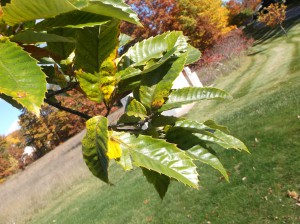
Here it is necessary to provide background for my curiosity. The American chestnut, Castanea dentata, was a grand component of the eastern American hardwood forest throughout the nineteenth century. In Michigan it naturally penetrated as far north as St. Clair county and was locally abundant in Monroe and Wayne counties in Southeastern Michigan. Beginning about 1900 the tree suffered the attack of a vicious fungus, Cryphonectria parasitica, likely imported from Asia, which destroyed American chestnuts everywhere. By 1940 the tree had largely disappeared from American forests, though suckers from dead trees continued to sprout for years afterwards, only to die upon reaching maturity.
The American chestnut should be distinguished from the horsechestnut, Aesculus hippocastanea, a tree commonly planted around homes. That tree, a permanent resident arrived from Europe after white settlement here, displays candelabras of white blossoms in June, finally producing inedible nuts that resemble chestnuts in appearance. Contrary to expectation, it is not enjoyed by horses, neither the leaves nor the nuts, though folklore insists it cures COPD in those animals.
American chestnuts were planted in the Grand Traverse area from early times. I had seen individual trees planted near farms on Old Mission peninsula and had heard stories of trees planted elsewhere nearby. But had a whole grove of them survived, a grove planted in 1910? If they still lived, the trees would be more than a hundred years old. They would be magnificent.
The Grand Traverse Conservancy provided the key that would unlock the mystery of the hidden chestnut grove. In response to my query, Conservancy staffer Angie Lucas, plant expert extraordinaire, e-mailed me the Michigan Academician article. And there it was: the information I needed to find the chestnuts:
The grove, owned by James Rogers, is located at Chimney Corners (SE ¼ Sect. 35, T27N, R16W) at the top of the Point Betsie Moraine, a massive 300-foot glacial ridge which flanks the north shore of Crystal Lake.
I live in Traverse City and am scarcely familiar with Crystal Lake, but I had a human resource that would guide me to the proper coordinates: Dan Palmer, resident of Leelanau county, knowledgeable in forestry, brought up in Frankfort, and familiar with the back trails of Benzie county. We would explore the north of Crystal Lake and find these trees hidden in Chimney Corners.
To those who know Benzie County, Chimney Corners is hardly obscure. It is a venerable resort with roots going back to the early twentieth century. The lodge stands now as it did in 1908, its stone fireplace dominating the space as you enter, grooved beadboard woodwork, electric lights from an earlier time, collections of beach reading from the fifties, and the grit of sand on hardwood floors. The proprietors kindly allowed us to walk the ridge to see the chestnuts: Just follow “chestnut trail,” they said.
The three-hundred foot moraine was surmounted with breathlessness as our party proceeded up the trail. It was a steep climb through a maple, beech, and basswood forest of moderate age, but there was no sign of the sharply toothed leaves of Castanea dentata. Were we in the right place?
Then, up ahead, a clue, though not a felicitous one. An enormous white skeleton of a tree stripped of its bark with many of its larger branches fallen roundabout stood out in the shade of taller trees. It was long dead, likely a chestnut, given its size and location. My hopes dropped: They were gone, all of them.
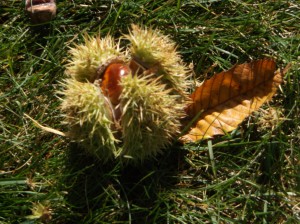
Still, we kept walking and along the trail were more dead trees, but some of them had suckers at the base that brandished the green leaves of living chestnuts. The forest floor, though, was not littered with the burs that encased the shiny chestnuts. Reproduction was not happening here: the shoots would live for a decade and die before flowering. The chestnut grove was doomed.
As we walked out of the forest, there were more dead trees, but as we came into a sunnier place, the chestnut suckers—offshoots–were more robust, as much as five inches in diameter, some of them reaching twenty-five feet or more into the sky. Green spikes of flowers appeared at the end of twigs, vague promises that chestnuts might be found in autumn at this place. We found a few burs from last year, the chestnuts missing from inside, either because the trees had not enough energy to make the nuts or because squirrels had devoured them.
Cankers caused by Cryphonectria parasitica appeared on the small stems of the chestnut suckers: the trees were unhealthy and would not live much longer. It would be a race between their mortality and their ability to produce nuts that would grow into the next generation. Remembering the fate of the white giants within the forest, I would bet on the fungus to destroy the trees before they could reproduce. There is good reason that Castanea dentata disappeared from the eastern United States.
The story could end here, but there is another thread to follow. The Grand Traverse Conservancy has just acquired a beautiful parcel of land from the estate of Naomi Borwell. Located just inside Manistee county off Manistee County Line Road, it offers a diversity of habitats: hardwood forests, deep valleys, frontage on the Betsie River, swamps, and a developed farm planted with a variety of interesting trees: spruces, birches, hawthorns—even a row of shagbark hickories—unusual in this part of Michigan. Best of all, there is a grove of American chestnuts with diameters of twelve inches, standing 45 feet high—though the ugly cankers on the large branches indicate the disease has penetrated here, too. You get the feeling the chestnut plantation is waiting its doom–which lurks in its very near future.
In nature it is unfair to take sides, though we do it all the time. Cryphonectria parasitica depends upon American chestnuts for its survival, but the fungus does not charm us with its form or grace. I have read of numerous attempts to hybridize the American chestnut with Asian forms that have a degree of resistance to the disease: you can learn about those efforts at the American Chestnut Foundation, http://www.acf.org/FAQ.php It seems likely that blight-resistant chestnuts with American chestnut features will become available within a decade or two, though the degree of resistance has not been determined as of now.
Perhaps it will be years before we can obtain American chestnuts to plant beside our homes without fear of the fungus destroying the trees, but when that time comes, I will be among the first to get them, God willing. With its glorious history in our forests, its stately grace, its delicious fruit, the American chestnut is too splendid for us to abandon.
Postscript
Sometimes stories refuse to end, no matter how hard you try to bring them to a conclusion. A friend at the public library informed me that he was quite sure a Michigan champion American Chestnut could be found at the end of Old Mission Peninsula. After a few days he emailed me the specifics: according to the Michigan Botanist, Volume 37, 1995, an enormous tree could be found off Old Mission Road, quite close to the country store, a bit past a curve, off a drive heading towards a cherry orchard. Could it still exist 20 years later?
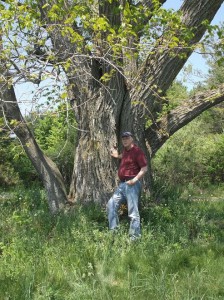
How could anyone do anything but drive out there and find out? Surprisingly, the directions were easy to follow and, with the help of a neighbor, Jim Hilt, my friend Marlas Hanson and I soon observed a tree towering in front of us, an American Chestnut far larger than any we had seen heretofore. Its trunk was split into three stems, twisted each one of them, and the canopy spread above over a wide area. It showed a few dead limbs, but it was alive—and not in bad shape for an old tree. There was no evidence of chestnut blight.
However, there was something peculiar about the tree: one would expect American Chestnut saplings round about, planted by squirrels that forgot where they sequestered the nuts, perhaps. But there were none to be found—not one. A few old burs from the previous year were scattered around the base of the tree, the nuts gone. It looked as if the tree had bothered to produce the spiny burs, but either they were empty from the start or else contained nuts that were infertile—or maybe every single one had been consumed by wildlife. In any case this American Chestnut had no offspring.
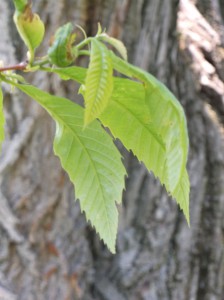
A puzzle: Does the very character that makes the tree infertile cause it to be resistant to blight? In other words, this tree—and another located three farms away—are the only ones I have seen that have not succumbed to the disease. Do they avoid blight because they are incapable of reproducing? Or is the answer simpler–that the champion Michigan tree needs other chestnuts nearby in order to obtain pollen for fertilization and that its infertility has nothing to do with its resistance? I do not know the answer, but I would like to find out–but to investigate that thread would take another year or two or five, and this story must end sometime. And so, let us end it here for now.
Richard Fidler is co-editor of Grand Traverse Journal.

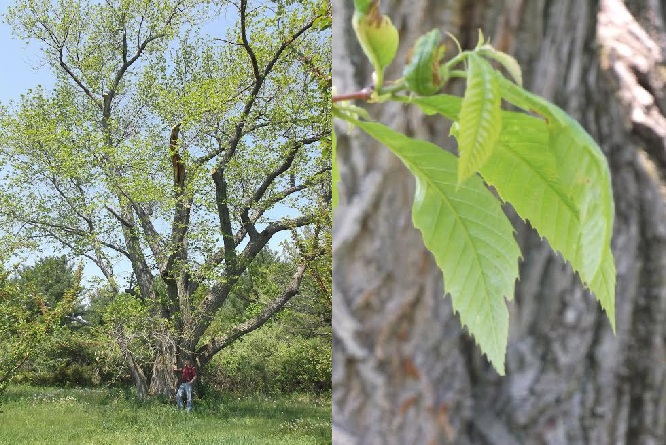
Dear Mr. Fidler,
I am also an admirer of the American Chestnut and know the history quite well. I am a member of TACF and several other organizations which work with Chestnut. I have grown and maintain approximately 300 American chestnut along with about the same number of Chinese and American/Chinese hybrids that I have crossed. To your question of the two large surviving American Chestnut that don’t seem to produce many seed you raised some possible explanations. I don’t know of any study to explain their survival due to something different in their make-up , i.e. correlation of disease resistance in non-nutbearing trees. However, I do know that trees situated beyond each other a certain distance , say , 600 feet or so, have a difficult time sharing pollen. Chestnut pollen is carried by the wind to a limited extent but insect pollinators are far more important I believe. I have noted large numbers of what appear to be houseflies or something similar and boxelder bugs and soldier beetles and an ocassional small bee that are very engaged in the male catkins. They carry the pollen onto the female flowers and if receptive , fertilazation occurs. Another possibility is that the chestnut trees you mentioned are from very different regional areas. As American chestnut ranged from Maine to Georgia regional genetic variation in the timing of the flowering can occur. That is, if a Chestnut source from South Carolina was planted by people on the Mission peninsula and some from Vermont as well they could very easily miss their pollination times when mature as the flowers would not be ready at the precise time and no pollination or very little would occur. This type of scenario would seem to be possible at the site you mentioned as people moved seed, seedling material around quite often years ago and today as well.
Other possibilities exist that may explain this phenomena and I would be happy to talk more if you wish. My wife and I intend to retire one day near Northport, Michigan where we purchased some beautiful property a number of years ago. As of now we reside in Plymouth, Indiana. I have many of my plantings and orchards located in northern Indiana and perform my own research on Chestnut, Butternut and several other hardwood trees.
I was glad to see your article and the interest it engendered for myself and no doubt for others.
Thank you,
Bill
You’ve given us a lot to think on here, Bill! We appreciate your interest and obvious knowledge… it is always fun to speculate with others of a like mind! Thank you for reading and commenting.
Dr. Dennis Fulbright will be presenting on Chestnuts at the Grand Traverse Conservation District’s Boardman Nature Center Community Room at 1450 Cass Road, TC, Wednesday, February 1, 2017 from 7:00-8:30 pm. He will be talking about the 13 species of Chestnut and how many are well suited for the GT area and offer a host of valuable benefits.
Thanks for the heads-up, Kama!
How tall is this tree and what is it’s diameter?
I am sorry I do not have recent measurements. According to Barnes and Wagner, Michigan Trees, measurements taken over 13 years ago give girth 208 inches, diameter 66.2 inches, height 64 feet. No doubt it is bigger now. However, I haven’t visited it in two years.
American Chestnuts Today
Wednesday, February 1, 2017
7:00-8:30 pm
Boardman Nature Center Community R oom
1450 Cass Road, TC
Contact Kama Ross, District Forester, Leelanau, Benzie, and Grand Traverse Conservation Districts, 231-256-9783, kama.ross@macd.org.
Neat, we’ll be sure to attend! Thanks for letting us all know, Kama!
I think I’ve found some American chestnuts in Grand Traverse County. Is there anything specific I can do or someone I can show?
Duke Elsner would know the tree. He’s at MSU extension.
I just read the book ” American Chestnut” by Susan Freinkel. I always wondered about a tree in my backyard, it is an American Chestnut. I live in Lowell MI. and have been wondering how rare this is and if any organization tracks these trees. According to the book there have been trees in TC, Grand Haven, Lansing and the Detriot/Toledo area.
Hello Bob! I couldn’t find a definitive answer to your question, but here’s a couple of leads to follow. You might try with The American Chestnut Association (https://www.acf.org/), or contact a Michigan State University Extension of Kent County for advice (msue.kent@county.msu.edu). Good luck, and congratulations on your tree, I’m sure it’s a beauty!
Hello, I’m travelling to the area at the beginning of September and would love to get a look at this tree! Is it on public land?